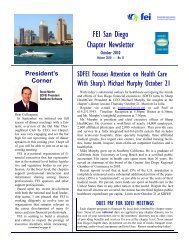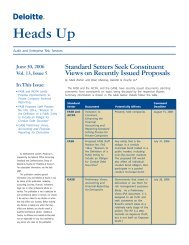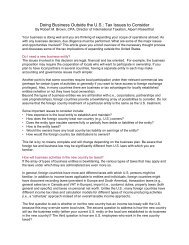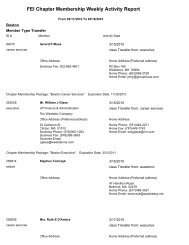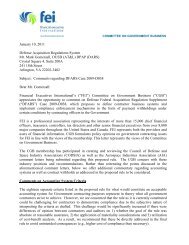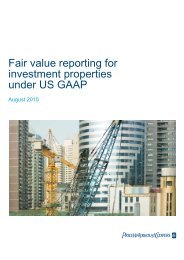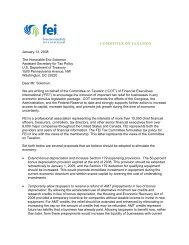FEI CCR Balance Sheet Offsetting Comment Letter - Financial ...
FEI CCR Balance Sheet Offsetting Comment Letter - Financial ...
FEI CCR Balance Sheet Offsetting Comment Letter - Financial ...
Create successful ePaper yourself
Turn your PDF publications into a flip-book with our unique Google optimized e-Paper software.
April 28, 2011<br />
<strong>Financial</strong> Accounting Standards Board International Accounting Standards Board<br />
401 Merritt 7 First Floor<br />
P.O. Box 5116 30 Cannon Street<br />
Norwalk, Connecticut 06856-5116 London EC4M 6XH<br />
U.S.A. UNITED KINGDOM<br />
By email: director@fasb.org By website: www.ifrs.org<br />
Re: FASB File Reference No. 2011-100 Re: IASB ED/2011/11<br />
Dear Madam or Sir:<br />
The Committee on Corporate Reporting (“<strong>CCR</strong>”) of <strong>Financial</strong> Executives International (“<strong>FEI</strong>”)<br />
wishes to share its views on the proposed Accounting Standards Update on <strong>Balance</strong> <strong>Sheet</strong> (Topic<br />
210), <strong>Offsetting</strong>, (the “Proposed ASU”) as issued by the <strong>Financial</strong> Accounting Standards Board<br />
(“FASB”), and the Exposure Draft ED/2011/11, <strong>Offsetting</strong> <strong>Financial</strong> Assets and <strong>Financial</strong><br />
Liabilities, as issued by the International Accounting Standards Board (“IASB”) (collectively,<br />
the “Exposure Drafts”). <strong>FEI</strong> is a leading international organization of senior financial<br />
executives. <strong>CCR</strong> is a technical committee of <strong>FEI</strong>, which reviews and responds to research<br />
studies, statements, pronouncements, pending legislation, proposals and other documents issued<br />
by domestic and international agencies and organizations. This document represents the views<br />
of <strong>CCR</strong> and not necessarily the views of <strong>FEI</strong> or its members individually.<br />
We fully support the continued efforts of both the FASB and the IASB (collectively, the<br />
“Boards”) to converge the FASB Accounting Standards Codification (“ASC” or “US GAAP”)<br />
with International <strong>Financial</strong> Reporting Standards (“IFRS”), as balance sheet offsetting currently<br />
creates a major difference in comparability of financial reporting between the two accounting<br />
models. However, we do not believe that the Exposure Drafts will result in an improvement to<br />
financial reporting currently applied under US GAAP. As such, a majority of our members<br />
would not support the Exposure Drafts and feel strongly that the proposed changes will not<br />
improve the quality of information provided to users of financial statements or be cost beneficial<br />
to the preparers of such financial statements. Further, we feel that if the Boards diverge on this<br />
issue, there will remain a major difference in comparability of balance sheet presentation for<br />
firms who use US GAAP versus IFRS as their primary accounting model. The divergence will<br />
also create an additional burden for preparers who currently follow IFRS for local reporting<br />
requirements, but follow US GAAP for their SEC filings on a consolidated basis. Therefore, we<br />
implore both Boards to converge to a model that more closely aligns with the current US GAAP
accounting model. In the attached appendix, we describe in more detail our specific concerns<br />
with regard to our position and to the questions posed within the Exposure Drafts.<br />
We appreciate the Boards’ consideration of these matters and welcome the opportunity to discuss<br />
any and all related matters. If you have questions, please contact Lorraine Malonza at (973) 765-<br />
1047 or lmalonza@financialexecutives.org.<br />
Sincerely,<br />
Loretta V. Cangialosi<br />
Chair, Committee on Corporate Reporting<br />
<strong>Financial</strong> Executives International<br />
Page | 2
Appendix<br />
Question 1 — <strong>Offsetting</strong> Criteria: Unconditional Right and Intention to Settle Net or<br />
Simultaneously<br />
The proposals would require an entity to offset a recognized eligible asset and a recognized<br />
eligible liability when the entity has an unconditional and legally enforceable right to setoff the<br />
eligible asset and eligible liability and intends either:<br />
1. To settle the eligible asset and eligible liability on a net basis,<br />
2. To realize the eligible asset and settle the eligible liability simultaneously.<br />
Do you agree with this proposed requirement? If not, why? What criteria would you propose<br />
instead and why?<br />
Cash Collateral under Derivative Contracts<br />
The Exposure Drafts require that an entity shall not offset recognized eligible financial assets and<br />
liabilities with assets pledged as collateral or the right to reclaim collateral pledged or the<br />
obligation to return collateral sold. One area of concern is the Exposure Drafts’ characterization<br />
of variation margin posted for exchange-traded and centrally-cleared derivatives. Paragraph C14<br />
specifically refers to margin accounts related to interest rate swap contracts, futures contracts,<br />
and exchange-traded written options, and requires that these margin accounts should be<br />
accounted as separate assets and liabilities. Margin accounts can take different legal forms, and<br />
as such should not be generalized in the accounting guidance.<br />
For example, cash variation margin posted to an exchange for daily-margined futures contracts is<br />
deemed to be a legal settlement of the instrument, resulting in the recording of a net receivable or<br />
payable to the exchange at the end of the day, which will settle the next morning. The amount<br />
recorded on balance sheet is not the full fair value of the futures contract, as the requirement to<br />
provide margining on a daily basis and the resulting legal settlement does not result in the buildup<br />
of fair value of the instrument. As a result, we find the requirement to separately account for<br />
variation margin on exchange-traded instruments that are legally settled on a daily basis to be<br />
separating the unit of account of the instrument. We therefore ask the Boards to eliminate the<br />
requirement to separate the variation margin from the gross fair value of legally-settled,<br />
exchange-traded derivative contracts.<br />
Cash variation margin under certain centrally-cleared derivatives does not always constitute a<br />
legal form of settlement of the instrument as described above. However, the substance and intent<br />
of the daily variation margin is to settle the net exposure to match the same economic impact of<br />
those instruments that are legally settled. The cash variation margin will not be returned to the<br />
customer unless there is a favorable change in fair value. The amount posted as variation margin<br />
will eventually be used to close out the customer’s position on a net basis upon termination or<br />
maturity. As discussed above, due to daily posting of cash variation margin, there exists no build<br />
up of fair value of the instrument to the customer as cash has already been posted and used to<br />
reduce the risk exposure inherent in the instrument. Similarly, cash collateral posted on bilateral<br />
Page | 3
over-the-counter (“OTC”) contracts also have the substance and intent of settling the net<br />
exposure, although the variation margin may not be transferred on a daily basis resulting in an<br />
uncollateralized portion of the gross exposure. Regardless of the frequency of cash variation<br />
margin payments, we feel that recording of gross exposures on the balance sheet with separate<br />
accounts for margin does not reflect the true assets and liabilities of an entity, since they will be<br />
net settled upon termination of the instrument and/or ultimate bankruptcy of the entity under the<br />
rules of the exchange or clearinghouse for centrally-cleared derivatives or under master netting<br />
agreements as used in bilateral OTC derivative contracts.<br />
We note the Boards wanted to reflect gross balances of instruments on the face of the balance<br />
sheet and did not want to offset only certain risks such as liquidity or credit risk. However, it is<br />
our belief that at a reporting date, the balance sheet should reflect assets and liabilities that will<br />
be settled on a net basis. In the case of posting cash collateral to reduce the overall exposure of<br />
derivative contracts, we do not favor a linked-presentation model, but feel offsetting the cash<br />
margin amounts is appropriate within the balance sheet as of the reporting date as the cash<br />
margin has reduced the outstanding risks both legally, in the case of futures contracts, and in<br />
substance for all other types of derivatives. Risks other than liquidity or credit risk inherent in the<br />
instrument cannot be derived from a balance sheet presentation, and can only be fully understood<br />
from disclosure in the notes to the financial statements, as currently required on a gross basis by<br />
underlying risk and product type under US GAAP. We therefore ask the Boards to allow the<br />
offset of cash collateral with the fair value of derivative contracts on the face of the balance sheet<br />
and to align the disclosure requirements concerning derivative contracts under both US GAAP<br />
and IFRS. See additional comments on disclosures in our response to Question 4.<br />
Payment Netting<br />
We ask the Boards for additional application guidance for the criteria on the intent to settle net,<br />
especially for the offset of contracts with various cash flows during their life. If two financial<br />
instruments have the legally enforceable right to offset, would all cash flows of those two<br />
contracts need to settle net or simultaneously to apply an offset of the asset and liability balance?<br />
Similarly, if instruments have differing maturity dates, but the underlying cash flows match<br />
during the life of the shorter duration instrument, can the shorter duration instrument be offset<br />
with the longer duration instrument during the life of the shorter duration contract? For example,<br />
a vanilla interest rate swap derivative contract typically has no payment at maturity since there is<br />
a zero fair value at maturity. We contend that as long as the maturity date is the same for a<br />
repurchase agreement and a reverse repurchase agreement, offsetting of the principal balances is<br />
warranted, if other offsetting criteria are met, even though the periodic interest payments may not<br />
match during their lives. Specific examples of cash flows on eligible financial instruments<br />
include periodic interest or premium payments, the fixed leg vs. floating leg of an individual<br />
swap contract, exchange of payments in different currencies, initial and final payments in<br />
different currencies under a single contract such as cross-currency swap, payments at final<br />
maturity, etc. It is unclear within the guidance whether all of these cash flows must match to<br />
achieve balance sheet offset.<br />
In addition, it is unclear if companies should pierce the unit of account and offset the portion of<br />
the asset or liability that relates only to the underlying cash payments that settle net or<br />
simultaneously. For example, if one swap contract pays interest quarterly and another swap<br />
Page | 4
contract receives semi-annually, would a portion of the asset and liability balance relating only to<br />
those payments that net on a semi-annual basis be able to offset? We ask the Boards to propose<br />
a reasonable and operationally efficient manner to analyze payment netting, since current<br />
financial reporting systems do not currently allow the matching of all individual payments across<br />
instruments. This will require significant system enhancements to achieve matching of all cash<br />
flows and/or the offset of partial assets and liabilities if the unit of account is to be pierced.<br />
Simultaneous Settlement<br />
The Exposure Drafts define simultaneous settlement as having to occur at the same moment, i.e.,<br />
there is exposure to only the net or reduced amount. We find that this requirement is<br />
operationally impossible to verify and unreasonably strict. In ASC Subtopic 210-20-45, the<br />
FASB reached a determination that the clearing and settlement mechanism described therein<br />
constituted the “functional equivalent of net settlement” for repurchase and reverse repurchase<br />
agreements. Many preparers under current IFRS also consider this guidance in their application<br />
of IAS 32 (as currently interpreted). IAS 32 states that the operation of a clearinghouse leads to<br />
the equivalent of net settlement. Current practice under IFRS is to apply simultaneous settlement<br />
to transactions that settle through a central clearinghouse in the same account on the same day.<br />
Many repurchase agreements reverse repurchase agreements, and securities lending/borrowing<br />
agreements settle based on a batch process whereby positions that settle on a given day will be<br />
processed at different points during the day based on systematic/administrative limitations. The<br />
Exposure Drafts do not reflect how settlement systems in the capital markets operate and would<br />
result in a significant change in accounting practice merely based on the “form” of settlement<br />
focusing on logistical or immaterial timing differences. The substance of inter-day settlements<br />
gives adequate credit and liquidity risk protection, along with the other credit risk mitigators in<br />
place at clearinghouses, such as daylight overdraft protection, lines of credit, and excess<br />
collateralization.<br />
It is impossible to verify when settlement is performed at the clearinghouse between<br />
counterparties as described above. Therefore, we feel that the settlement on the same day with<br />
both counterparties significantly reduces both credit and liquidity risk. We strongly recommend<br />
that the Boards redeliberate this criterion to align with current practice.<br />
Requirement of Offset<br />
Many of our members who are not financial institutions do not have significant portfolios of<br />
eligible financial assets and liabilities that fall within the scope of the Exposure Drafts,<br />
specifically derivatives or repurchase agreements. Under US GAAP, presentation of these<br />
balances is reported on a gross basis. Although the current criteria in the Exposure Drafts have<br />
considerable hurdles to achieve offset on the face of the balance sheet, they would now “require”<br />
offsetting of eligible financial assets and liabilities. Some of our members would like the<br />
opportunity to report eligible financial assets and liabilities on a gross basis if they do not<br />
consider the impact to be material to the balance sheet. We believe that the search for<br />
unrecorded netting would be onerous and costly to preparers with little benefit to users. In<br />
addition, please see comments on the scope of the disclosure requirements as mentioned in the<br />
Question 4.<br />
Page | 5
Specific Industry Guidance under US GAAP<br />
Amendments to ASC Subtopic 910-405 – Contractors-Construction<br />
We noted the Proposed ASU would eliminate the construction contractor industry guidance that<br />
allowed offsetting of customer advances against work in process on cost-plus contracts.<br />
However, we also noted the Proposed ASU does not include conforming amendments to the<br />
Federal Government contractor industry guidance that permits offsetting customer advances<br />
against work in process (ASC paragraph 912-405-45-6). We assume the Proposed ASU did not<br />
include these conforming amendments because the Federal Government takes title to and has an<br />
unconditional obligation to pay its contractors for work in process. We request the Boards<br />
clarify why the construction contractor industry guidance on how customer advances should be<br />
presented on the balance sheet would be eliminated while the Federal Government contractor<br />
industry guidance would be retained.<br />
Furthermore, the Proposed ASU does not eliminate the Revenue Recognition (ASU Topic 605)<br />
guidance on how customer advances on construction and production-type contracts should be<br />
presented on the balance sheet (ASC paragraphs 605-35-45-3 to 5). We assume the Proposed<br />
ASU does not eliminate this guidance because Revenue Recognition (Topic 605) is expected to<br />
be superseded in its entirety by the proposed Accounting Standards Update (Topic 605), Revenue<br />
Recognition, (“Proposed Revenue ASU”). Our interpretation of the Proposed Revenue ASU is<br />
that customer advances are required to be offset against unbilled receivables. However,<br />
offsetting customer advances against work in process would not be permitted. We believe<br />
construction contracts are intended to qualify for continuous transfer of control under the<br />
Proposed Revenue ASU and depending on the method chosen for measuring progress and<br />
recognizing revenue, the accumulated cost incurred to date would either be captured in unbilled<br />
receivables (e.g. cost-to-cost approach) or work in progress (e.g. units of delivery). Therefore,<br />
customer advances would be recorded net against unbilled receivables if the cost to cost method<br />
is chosen and gross as a liability under a unit of delivery approach. It is unclear as to why there<br />
would be differing balance sheet presentation based on the method selected to measure progress.<br />
We do not agree with what appears to be the Board’s decision to prohibit offsetting customer<br />
advances against work in process when contracts qualify for continuous transfer of control. We<br />
believe offsetting customer advances against both unbilled receivables and work in process<br />
should be allowed for contracts that meet the continuous transfer criteria.<br />
Question 2 — Unconditional Right of Offset Must Be Enforceable in All Circumstances<br />
Under the proposals, eligible assets and eligible liabilities must be offset if, and only if, they are<br />
subject to an unconditional and legally enforceable right of setoff. The proposals specify that an<br />
unconditional and legally enforceable right of setoff is enforceable in all circumstances (that is,<br />
it is enforceable in the normal course of business and on the default, insolvency, or bankruptcy<br />
of a counterparty) and its exercisability is not contingent on a future event. Do you agree with<br />
this proposed requirement? If not, why? What would you propose instead and why?<br />
We have concerns that the requirement of unconditional right of offset is too strict. We<br />
understand that the Boards did not want to reflect the offset of only certain risks on the balance<br />
sheet, such as credit risk. However, the offset of financial assets and liabilities under conditional<br />
Page | 6
netting agreements does not make a significant change to the information gathered from the face<br />
of the balance sheet. If there is an intention to settle net, contracts with the same counterparty<br />
will be offset at termination, maturity, and/or bankruptcy of the counterparty or the reporting<br />
entity. This was proven to be effective, even in the recent financial crisis. <strong>Financial</strong> assets and<br />
liabilities under master netting agreements, regardless of their unconditional or conditional<br />
rights, would be offset if the counterparty fell into bankruptcy. In some jurisdictions, the gross<br />
assets would not be available to other creditors, and therefore, reflecting gross assets and<br />
liabilities on the face of the balance sheet would not give faithful and relevant information to a<br />
user as those assets and liabilities are inextricably linked. The analysis of gross risks inherent in<br />
each of the financial instruments subject to offset can only be derived from disclosure in the<br />
notes to the financial statements. We therefore believe that a legally enforceable right of offset<br />
regardless of conditionality is sufficient for netting of financial instruments on the face of the<br />
balance sheet.<br />
Question 3 — Multilateral Setoff Arrangements<br />
The proposals would require offsetting for both bilateral and multilateral setoff arrangements<br />
that meet the offsetting criteria. Do you agree that the offsetting criteria should be applied to<br />
both bilateral and multilateral setoff arrangements? If not, why? What would you propose<br />
instead, and why? What are some of the common situations in which a multilateral right of<br />
setoff may be present?<br />
We agree that offsetting shall be permitted between multiple parties if the offsetting criteria are<br />
met. Multilateral arrangements exist in certain master netting agreements between the<br />
counterparty and various affiliates of the reporting entity. Currently, these agreements are<br />
conditional in nature, as netting is subject to default of one of the counterparties of the<br />
agreement, and would not meet the criteria under the Exposure Drafts. As mentioned in our<br />
response under Question 2, we believe that if an unconditional right of offset is not required,<br />
netting under multilateral arrangements would be more prevalent under an accounting model<br />
based on current US GAAP.<br />
Question 4 — Disclosures<br />
Do you agree with the proposed disclosure requirements in paragraphs 11–15? If not, why?<br />
How would you propose to amend those requirements and why?<br />
We agree that disclosures relating to gross amounts of financial assets and financial liabilities<br />
provide valuable information to users of financial statements to understand the inherent risks by<br />
product type. Currently, these disclosures are only required for derivative assets and liabilities<br />
under FASB ASC Topic 815, Derivatives and Hedging, but are not required for other product<br />
types or in any disclosures under IFRS. We believe that disclosures of the gross and net balances<br />
of eligible financial assets and liabilities should be consistent across all types of financial<br />
instruments, but not in the detail as prescribed in the Exposure Drafts. For the detail disclosures<br />
as proposed, the benefits for the users of financial statements do not outweigh the efforts and<br />
Page | 7
costs for collecting the data. Not all information required for the proposed disclosures is readily<br />
available from current financial reporting systems.<br />
In particular, the requirement to disclose the portfolio-level adjustments for credit risk is a<br />
valuation methodology issue and relates to a valuation reserve, i.e., a portion of the fair value of<br />
the group of instruments, to reflect an exit price of the portfolio and would be better placed<br />
within disclosures on fair value measurement. A valuation reserve is not an offset of gross<br />
financial assets and liabilities and may mislead users of the financial statements. In addition, the<br />
concept of portfolio-level adjustments is not currently within US GAAP or IFRS as the FASB<br />
ASU for Topic 820 and IFRS 13 have not yet been issued. If the guidance for portfolio-level<br />
adjustments will be prospective in nature effective in future periods, a retrospective application<br />
of the netting disclosures is incongruous. In addition, we do not believe that the breakdown<br />
between unconditional and conditional netting that was not achieved within the balance sheet is<br />
relevant to users. If for any reason the netting criteria are not met, users will not benefit from the<br />
reason why netting was not achieved. Although we do believe, as mentioned above, that the<br />
differentiation between unconditional and conditional netting arrangements should not matter for<br />
netting within the balance sheet, we also do not believe that the disclosure of that differentiation<br />
is relevant to users. The differentiation of the type of netting arrangements by product type will<br />
be extremely difficult to collect from financial reporting systems and can be described more<br />
effectively in a qualitative nature.<br />
We also ask the Boards for additional clarification on the population of instruments to be<br />
considered for inclusion in the proposed disclosures. As the Exposure Drafts require netting for<br />
eligible financial assets and liabilities, entities will need to determine where netting might be<br />
eligible in certain remote conditions or where there is no intention to settle net. This effort to<br />
identify and quantify eligible netting would be necessary to comply with the netting disclosures<br />
where the netting criteria are not met within the balance sheet, but would be required to be<br />
included in the disclosures. We believe that this search for unrecorded netting would be onerous<br />
and costly to preparers with little benefit to users and therefore should be excluded from the<br />
proposed disclosures for eligible financial instruments that are not intended to be offset. In<br />
addition, there are many instances where instruments may be collateralized by cash or other<br />
financial instruments where no netting has been achieved in the past under either US GAAP or<br />
IFRS, e.g., loan receivables or issued debt. We do not believe that these types of financial<br />
instruments should be included in the scope of the disclosures simply because they do not meet<br />
the netting criteria, but are only collateralized vanilla instruments. We believe that disclosure of<br />
collateral is best placed within the footnotes of those specific product types and described in a<br />
qualitative nature.<br />
Question 5 — Effective Date and Transition<br />
Do you agree with the proposed transition requirements in Appendix A? If not, why? How<br />
would you propose to amend those requirements and why? Please provide an estimate of how<br />
long an entity would reasonably require to implement the proposed requirements.<br />
The proposed guidance will cause a significant departure from practice under US GAAP and<br />
may affect certain aspects of netting under IFRS. We expect that for our members who have<br />
Page | 8
significant portfolios of derivatives, changes in systems will be required to achieve the level of<br />
detail prescribed by the proposed disclosures. In addition, all firms will need to perform an<br />
exhaustive search of potential netting relationships that are not identified under current netting<br />
guidance and determine how this information will be collected in future reporting periods. Since<br />
the transition guidance requires retrospective application to previous reporting periods and a<br />
significant change in the reporting systems, we believe that the effective date of the new<br />
guidance should be no sooner than reporting periods beginning 1 January 2015. This should<br />
coincide with the timeline of implementation for other converged standards, specifically the<br />
Boards’ project on <strong>Financial</strong> Instruments.<br />
Other Considerations<br />
Intercompany Assets and Liabilities<br />
It is unclear whether the Exposure Drafts intend to include or exclude intercompany assets and<br />
liabilities. The Exposure Drafts do not make reference to any changes to International<br />
Accounting Standard 27, Consolidated and Separate <strong>Financial</strong> Statements, or to FASB ASC<br />
topic 810-10-45, Consolidation: Other Presentation Matters, which states:<br />
45-1 In the preparation of consolidated financial statements, intra-entity balances and<br />
transactions shall be eliminated. This includes intra-entity open account balances,<br />
security holdings, sales and purchases, interest, dividends, and so forth. As consolidated<br />
financial statements are based on the assumption that they represent the financial position<br />
and operating results of a single economic entity, such statements shall not include gain<br />
or loss on transactions among the entities in the consolidated group. 1<br />
If the intention was to exclude intercompany assets and liabilities, then we recommend that the<br />
proposal should contain more specific language for preparers to better understand the scope of<br />
the proposal. We contend that the Exposure Drafts should not amend current guidance relating<br />
to intercompany assets and liabilities of a consolidated group.<br />
If the intention was to include intercompany assets and liabilities in the scope of the Exposure<br />
Drafts, we would strongly oppose such a change. We feel that the current consolidation<br />
guidance that permits netting of intercompany assets and liabilities is the preferred reporting,<br />
especially in companies where the subsidiary is 100% owned and consolidated by the parent.<br />
We do not feel that there is any additional benefit to users by grossing up intercompany assets<br />
and liabilities that would otherwise net to zero. Further, grossing up intercompany assets and<br />
liabilities would greatly inflate the balance sheets of many corporate entities and distort financial<br />
ratios, without providing any further information regarding the true risks and exposures of the<br />
consolidated company.<br />
As this issue was not addressed in the Exposure Drafts, it is our hope that the intention of the<br />
Boards was to scope intercompany assets and liabilities out of the <strong>Balance</strong> <strong>Sheet</strong> <strong>Offsetting</strong><br />
guidance for consolidated reporting. If the intention was to include intercompany assets and<br />
1 Similar guidance is included in paragraphs 20 – 21 of IAS 27 under IFRS.<br />
Page | 9
liabilities, then we recommend that the Boards provide constituents with more time to consider<br />
the implications of such a change.<br />
As an additional example, some of our members have cash pooling arrangements that utilize a<br />
third party bank (the “pool”) to provide multi-currency cash pooling for their international<br />
subsidiaries. Depositing subsidiaries transfer eligible cash amounts to the pool. Withdrawing<br />
subsidiaries are then able to borrow money from the pool, with the deposits serving as collateral<br />
for these loans. These arrangements also contain a master netting agreement between the parent<br />
company and the facilitating bank. Current practice is to show the net amount of cash on the<br />
consolidated balance sheet, whereas in individual stand-alone financial statements, gross cash<br />
balances are reflected by the depositing subsidiaries and liability balances are reflected by the<br />
borrowing subsidiaries. The requirements under the Exposure Drafts would seem to suggest that<br />
the deposits made into the pool and the subsidiary borrowings should be shown gross on the face<br />
of the consolidated group’s balance sheet. This display would be contrary to the economics of<br />
the transaction. The facilitating bank, through the master netting agreement has not taken on any<br />
risk of the individual loan and deposit of each subsidiary. It only has a risk relative to the net<br />
position of the corporation.<br />
Our view is that gross presentation of this activity on the face of the consolidated balance sheet<br />
accompanied by a reconciliation to the net amount in the footnotes would not necessarily provide<br />
financial statement users with more useful information with regard to an entity’s overall liquidity<br />
position. Investors focus primarily on the entity’s cash management and more specifically the<br />
use of excess funds. Gross presentation on the face of the consolidated balance sheet could be<br />
misleading to investors as it would misrepresent the true level of excess cash available for<br />
activities such as the repurchase of own stock, business acquisitions, debt repayment, etc.<br />
Although footnotes would provide a reconciliation of the gross and net balances, investors are<br />
more focused on the net balance and therefore we believe that gross presentation on the face of<br />
the consolidated balance sheet would present undue prominence of this amount.<br />
We also believe that the level of disclosures would significantly increase as a result of the<br />
Exposure Drafts, due to their explicit requirements, but also due to the additional disclosures that<br />
we believe would be needed to provide users of the consolidated financial statements with an<br />
understanding of the reported cash balance. In addition, the proposals in the Exposure Drafts<br />
would necessitate the statement of cash flows to be reconciled to the gross cash balance recorded<br />
on the face of the consolidated balance sheet rather than the net balance currently recorded.<br />
Consequently, we believe that consideration would need to be given to presentational issues that<br />
may arise in respect of deposits into and withdrawals from the pool and their classification<br />
within the sections of Operating and Financing Activities. We believe that this would require<br />
further additional disclosures to explain the activity within each section. We do not believe that<br />
this increased volume of disclosures would necessarily provide more useful information to users.<br />
Page | 10



